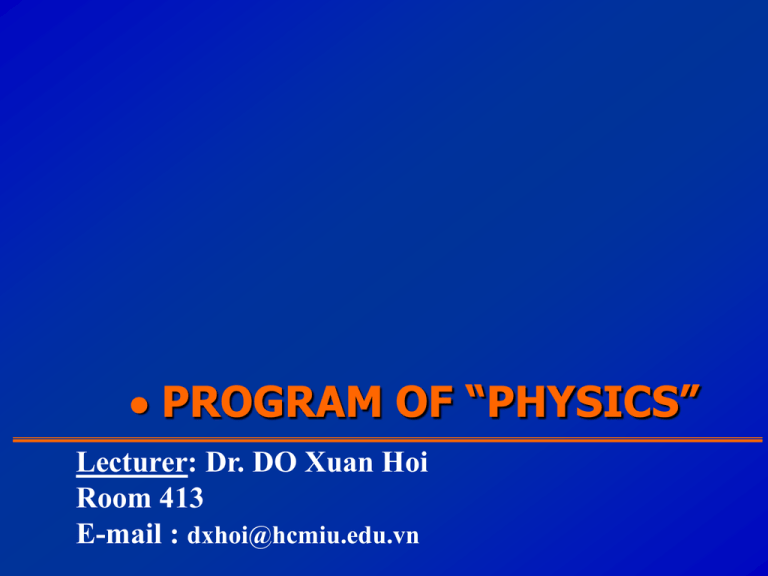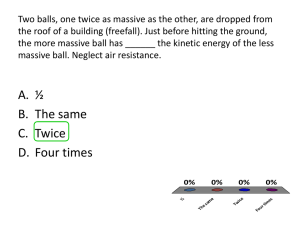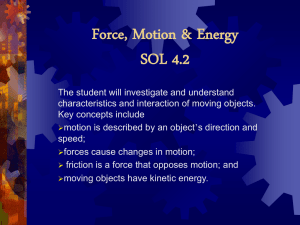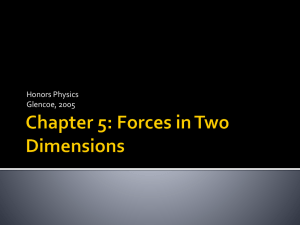(a) (b)
advertisement

PROGRAM OF “PHYSICS” Lecturer: Dr. DO Xuan Hoi Room 413 E-mail : dxhoi@hcmiu.edu.vn PHYSICS I (General Mechanics) 02 credits (30 periods) Chapter 1 Bases of Kinematics Motion in One Dimension Motion in Two Dimensions Chapter 2 The Laws of Motion Chapter 3 Work and Mechanical Energy Chapter 4 Linear Momentum and Collisions Chapter 5 Rotation of a Rigid Object About a Fixed Axis Chapter 6 Static Equilibrium Chapter 7 Universal Gravitation References : Halliday D., Resnick R. and Walker, J. (2005), Fundamentals of Physics, Extended seventh edition. John Willey and Sons, Inc. Alonso M. and Finn E.J. (1992). Physics, AddisonWesley Publishing Company Hecht, E. (2000). Physics. Calculus, Second Edition. Brooks/Cole. Faughn/Serway (2006), Serway’s College Physics, Brooks/Cole. Roger Muncaster (1994), A-Level Physics, Stanley Thornes. http://ocw.mit.edu/OcwWeb/Physics/index.htm http://www.opensourcephysics.org/index.html http://hyperphysics.phyastr.gsu.edu/hbase/HFrame.html http://www.practicalphysics.org/go/Default.ht ml http://www.msm.cam.ac.uk/ http://www.iop.org/index.html . . . PHYSICS I Chapter 3 Work and Mechanical Energy Work Done by Force. Power Kinetic Energy and the Work. Potential Energy of a System Conservative and Non-conservative Forces Conservation of Mechanical Energy Changes in Mechanical Energy for Non-conservative Forces Relationship Between Conservative Forces and Potential Energy Introduction Forms of energy: Mechanical focus for now chemical electromagnetic nuclear Energy can be transformed from one form to another Essential to the study of physics, chemistry, biology, geology, astronomy Can be used in place of Newton’s laws to solve certain problems more simply 1 Work Done by Force. Power Provides a link between force and energy The work, W, done by a constant force on an object is defined as the product of the component of the force along the direction of displacement and the magnitude of the displacement W (F cos )x (F cos θ) is the component of the force in the direction of the displacement Δx is the displacement (F cos θ) is the component of the force in the direction of the displacement By using the scalar product (dot product) : W (F cos )x F .x Work can be positive or negative Positive if the force and the displacement are in the same direction Negative if the force and the displacement are in the opposite direction Example 1: lifting a cement block… Work done by the person: is positive when lifting the box is negative when lowering the box Example 2: … then moving it horizontally Work done by gravity: is negative when lifting the box is positive when lowering the box is zero when moving it horizontally Total work : W W1 W2 W3 mgh mgh 0 0 lifting lowering moving total EXAMPLE 1 A particle moving in the xy plane undergoes a displacement d = (2.0i + 3.0j) m as a constant force F = (5.0i + 2.0j) N acts on the particle. (a) Calculate the magnitude of the displacement and that of the force. (b) Calculate the work done by F. (c) Calculate the angle between F and d. (a) d 2.02 3.02 3.6 m F 5.02 2.02 5.4 N (b) W = F.d = ( 2.0i + 3.0j )(5.0i + 2.0j ) 16 J W 16 J (c) cos ; 35o F .d 3.6 N 5.4 m WORK DONE BY A VARYING FORCE Split total displacement (xf - xi) into many small displacements x For each small displacement: Wi (F cos )x i Thus, total work is: Wtot Wi Fx xi i i which is total area under the F(x) curve! lim x 0 xf xf i i F x x F x dx x x W xf x F x dx i PROBLEM 1 The interplanetary probe shown in the figure is attracted to the Sun by a force of magnitude F = - (1.3 10-23)/x 2 where x is the distance measured outward from the Sun to the probe. Determine how much work is done by the Sun on the probe as the probe–Sun separation changes from 1.5 1011 m to 2.3 1011 m SOLUTION PROBLEM 2 A block on a horizontal, frictionless surface is connected to a spring. The spring exerts on the block a force of magnitude F = - kx , where x is the displacement of the block from its unstretched (x = 0) position and k is a positive constant called the force constant of the spring. Determine the work done by the spring force when the block undergoes an arbitrary displacement from x = xi to x = xf . W xf SOLUTION x F x dx i xf x x f i 1 2 1 2 (kx )dx kx kx 2 xi 2 xf xi 1 2 1 2 W kx i kx f 2 2 WORK DONE BY THE GRAVITATIONAL FORCE Divide the path into small segments s mg mgj s xi yj mg W F s mg (xi yj ) mg (xi ) mg (yj ) i j 0 mg y The total work done by the gravitational force : W mg (y 2 y 1 ) The work done by the gravitational force does not depend on the path; it depends only on the vertical distance POWER General definition : the time rate of energy transfer. If an external force is applied to an object and if the work done by this force in the time interval t is W , then the average power expended during this interval is defined as : W P t horsepower (hp):746 W J/s W The instantaneous power is the limiting value of the average power as t approaches zero : W dW P lim t 0 t dt ds dW Fds ; P F Fv dt EXAMPLE 2 An elevator car has a mass of 1 000 kg and is carrying passengers having a combined mass of 800 kg. A constant frictional force of 4 000 N retards its motion upward. What must be the minimum power delivered by the motor to lift the elevator car at a constant speed of 3.00 m/s? FY =T f fric Mg 0 ; T f fric Mg T 4.00 103 N (1.80 103 kg ) (9.80 m / s 2 ) 2.16 104 N 4 4 P Tv Tv 2.16 10 N 3.00 m / s 6.48 10 W 2 Kinetic energy and the work Kinetic energy : Energy associated with the motion of an object Scalar quantity with the same units as work Work is related to kinetic energy Let F be a constant force: Wnet Fs (ma )s , but : v 2 v 02 2a s , or a s Thus :W net v 2 v 02 2 . v 2 v 02 1 1 2 m mv mv 0 2 . 2 2 2 1 2 This quantity is called kinetic energy: KE = mv 2 1 2 1 2 Wnet mv 2 mv 02 . 1 KE = mv 2 2 Kinetic Energy Theorem (or The work–kinetic energy theorem) “ The net work done on a particle by external forces equals the change in kinetic energy of the particle” Wnet KE KE f KE i Speed will increase if work is positive Speed will decrease if work is negative PROBLEM 3 Derived the work–kinetic energy theorem when the force varies SOLUTION W xf xf i i x F x dx x ma x dx dv dv dx dv a v dt dx dt dx xf vf dv W mv dx mvdv dx xi vi 1 1 2 W mv f mv i2 2 2 Test Two marbles, one twice as heavy as the other, are dropped to the ground from the roof of a building. Just before hitting the ground, the heavier marble has one. 1. as much kinetic energy as the lighter one. 2. twice as much kinetic energy as the lighter 3. half as much kinetic energy as the lighter one. 4. four times as much kinetic energy as the lighter one. 5. impossible to determine. EXAMPLE 3 A 6.0-kg block initially at rest is pulled to the right along a horizontal, frictionless surface by a constant horizontal force of 12 N. (a) Find the speed of the block after it has moved 3.0 m. (a) W Fd (12 N )(3.0 m ) 36 J 1 Wnet KE KE f KE i mv f2 0 2 2(36 J ) 2W 3.5 m / s vf 6.0 kg m EXAMPLE 3 A 6.0-kg block initially at rest is pulled to the right along a horizontal, frictionless surface by a constant horizontal force of 12 N. (b) Find the final speed of the block if the surface has a coefficient of kinetic friction of 0.15. (b) f k k n k mg (0.15)(6.0 kg )(9.80 m / s 2 ) 8.82 N Wfric Fk d (8.82 N )(3.0 m ) 26.5 J 1 mv f2 0 Wnet 36 J 26.5 J 2 2(36 J 26.5 J ) vf 1.8 m / s 6.0 kg PROBLEM 4 A block of mass 1.6 kg is attached to a horizontal spring that has a force constant of 1.0 103 N/m, as shown in the figure. The spring is compressed 2.0 cm and is then released from rest. Use the result of PROBLEM 2. (a) Calculate the speed of the block as it passes through the equilibrium position x = 0 if the surface is frictionless SOLUTION (a) 1 2 1 2 W kx i kx f 2 2 1 (1.0 103 N / m )(2.0 10-2 m ) 0 0.20 J 2 1 W mv f2 0 ; v f 2 2W m 2(0.20 J ) 0.50 m / s 1.6 kg PROBLEM 4 A block of mass 1.6 kg is attached to a horizontal spring that has a force constant of 1.0 103 N/m, as shown in the figure. The spring is compressed 2.0 cm and is then released from rest. Use the result of PROBLEM 2. (b) Calculate the speed of the block as it passes through the equilibrium position if a constant frictional force of 4.0 N retards its motion from the moment it is released. SOLUTION (b) Wfric Fk d (4.0 N )(2.0 102 m ) 0.080 J Wnet 1 2 1 2 kx i kx f ; Wnet 0.20 J 0.08 J 0.12 J 2 2 Wnet 1 mv f2 0 ;v f 2 2Wnet m 2(0.12 J ) 0.39 m / s 1.6 kg 3. Potential Energy of a System ► ► Potential energy is associated with the position of the object within some system Potential energy is a property of the system, not the object A system is a collection of objects or particles interacting via forces or processes that are internal to the system Units of Potential Energy are the same as those of Work and Kinetic Energy 3.1 Gravitational Potential Energy ► ► ► Gravitational Potential Energy is the energy associated with the relative position of an object in space near the Earth’s surface Objects interact with the earth through the gravitational force Actually the potential energy of the earth-object system Consider block of mass m at initial height yi Work done by the gravitational force W grav F cos s mg y i y f mgy i mgy f Potential energy: PE grav U grav mgy Note: Wgravity U grav ,i U grav ,f Important: work is related to the difference in PE’s! Reference Levels for Gravitational Potential Energy ► A location where the gravitational potential energy is zero must be chosen for each problem The choice is arbitrary since the change in the potential energy is the important quantity Choose a convenient location for the zero reference height ►often the Earth’s surface ►may be some other point suggested by the problem Reference Levels for Gravitational Potential Energy A location where the gravitational potential energy is zero must be chosen for each problem The choice is arbitrary since the change in the potential energy gives the work done Wgrav 1 mgy i mgy f 1 1 Wgrav 2 mgy i mgy f Wgrav 3 mgy i mgy f Wgrav 1 Wgrav 2 Wgrav 3 2 2 3 3 EXAMPLE 4 A bowling ball of a mass of approximately 7 kg held by a careless bowler slips from the from a height of 0.5 m and drops on the bowler’s toe which is about 0.03 m above the floor. (a) Choosing floor level as the y = 0 point of your coordinate system, estimate the total work done on the ball by the force of gravity as the ball falls. (a) U i mgy i (7 kg )(9.80 m / s 2 )(0.5 m) 34.3 J U f mgy f (7 kg )(9.80 m / s 2 )(0.03 m) 2.06 J Wg Wi Wf 34.3 J 2.06 J 32.24 J EXAMPLE 4 A bowling ball of a mass of approximately 7 kg held by a careless bowler slips from the from a height of 0.5 m and drops on the bowler’s toe which is about 0.03 m above the floor. (b) Repeat the calculation, using the top of the bowler’s head (which we estimate to be 1.50 m above the floor) as the origin of coordinates. (b) U i mgy i (7 kg )(9.80 m / s 2 )(1 m) 68.6 J U f mgy f (7 kg )(9.80 m / s 2 )(1.47 m) 100.8 J Wg Wi Wf 68.6 J (100.8 J ) 32.24 J PROBLEM 5 A small block with a mass of 0.120 kg is attached to a cord passing through a hole in a frictionless, horizontal surface.The block is originally revolving at a distance of 0.40 m from the hole with a speed of 0.70 m/s. The cord is then pulled from below, shortening the radius of the circle in which the block revolves to 0.10 m. At this new distance, the speed of the block is observed to be 2.80 m/s. (a) What is the tension in the cord in the original situation when the block has speed 0.70 m/s? SOLUTION (a) v 12 FR T 1 m r 1 (0.70 m / s )2 (0.120 kg ) 0.15 N 0.40 m PROBLEM 5 A small block with a mass of 0.120 kg is attached to a cord passing through a hole in a frictionless, horizontal surface.The block is originally revolving at a distance of 0.40 m from the hole with a speed of 0.70 m/s. The cord is then pulled from below, shortening the radius of the circle in which the block revolves to 0.10 m. At this new distance, the speed of the block is observed to be 2.80 m/s. (b) What is the tension in the cord in the final situation when the block has speed v = 2.80 m/s? 2 v (b) F T m 2 R 2 r2 (2.80 m / s )2 (0.120 kg ) 0.10 m 9.40 N PROBLEM 5 A small block with a mass of 0.120 kg is attached to a cord passing through a hole in a frictionless, horizontal surface.The block is originally revolving at a distance of 0.40 m from the hole with a speed of 0.70 m/s. The cord is then pulled from below, shortening the radius of the circle in which the block revolves to 0.10 m. At this new distance, the speed of the block is observed to be 2.80 m/s.(c) How much work was done by the person who pulled on the cord? SOLUTION (c) 1 1 2 W mv 2 mv 12 2 2 1 (0.120 kg ) (2.80 m / s )2 (0.70 m / s )2 2 0.44 J PROBLEM 6 You throw a 20-N rock vertically into the air from ground level. You observe that when it is 15.0 m above the ground, it is traveling at 25.0 m/s upward. Use the work-energy theorem to find (a) the rock's speed just as it left the ground and (b) its maximum height. SOLUTION 1 1 (a) W mgh mv 22 mv 12 ; v 1 2gh v 22 2 2 v 1 2 9.80 m / s 2 15.0 m (2.80 m / s )2 30.3 m / s (b) At the maximum height : v ’2 = 0 1 1 1 2 2 W ' mgh ' mv 2' mv 1 ; mgh ' 0 mv 12 2 2 2 2 2 v1 (30.3 m / s ) h' 46.8 m 2g 2 9.8 m / s PROBLEM 7 A boy skateboards down a curved playground ramp, he moves through a quarter-circle with radius R = 3.00 m. The total mass of this boy and his skateboard is 25.0 kg. He starts from rest and there is no friction. (a) Find his speed at the bottom of the ramp (b) Find the normal force that acts on him at the bottom of the curve. SOLUTION (a) 1 mv 22 1 mv 12 W mgh mgR ; 2 2 1 mv 22 0 mgR ; v 2 2gR 2 v 2 2 9.80 m / s 2 3.00 m 7.67 m / s PROBLEM 7 A boy skateboards down a curved playground ramp, he moves through a quarter-circle with radius R = 3.00 m. The total mass of this boy and his skateboard is 25.0 kg. He starts from rest and there is no friction. (a) Find his speed at the bottom of the ramp (b) Find the normal force that acts on him at the bottom of the curve. SOLUTION (b) At the bottom : v 22 2gR aR 2g R R n mg maR 2mg n 3mg 3 25.0 kg 9.80 m / s 2 735 N PROBLEM 8 We want to load a l2-kg crate into a truck by sliding it up a ramp 2.5 m long, inclined at 300. A worker, giving no thought to friction, calculates that he can get the crate up the ramp by giving it an initial speed of 5.0 m/s at the bottom and letting it go. But friction is not negligible; the crate slides 1.6 m up the ramp, stops, and slides back down. (a) Assuming that the friction force acting on the crate is constant, find its magnitude SOLUTION (a) Kinetic Energy Theorem Wnet KE KE f KE i 1 1 1 mv 22 mv 12 W mgh (f FRIC d ) ; 0 mv 12 mgh (f FRIC d ) ; 2 2 2 1 2 mv 1 mgh f FRIC 2 d PROBLEM 8 We want to load a l2-kg crate into a truck by sliding it up a ramp 2.5 m long, inclined at 300. A worker, giving no thought to friction, calculates that he can get the crate up the ramp by giving it an initial speed of 5.0 m/s at the bottom and letting it go. But friction is not negligible; the crate slides 1.6 m up the ramp, stops, and slides back down. (a) Assuming that the friction force acting on the crate is constant, find its magnitude SOLUTION f FRIC 1 mv 12 mgh 2 d 1 12 kg (5.0 m / s )2 12 kg 9.8 m / s 2 (1.6 m ) s in300 2 2.5 m 35 N PROBLEM 8 We want to load a l2-kg crate into a truck by sliding it up a ramp 2.5 m long, inclined at 300. A worker, giving no thought to friction, calculates that he can get the crate up the ramp by giving it an initial speed of 5.0 m/s at the bottom and letting it go. But friction is not negligible; the crate slides 1.6 m up the ramp, stops, and slides back down. (b) How fast is the crate moving when it reaches the bottom of the ramp? SOLUTION (b) 1 1 mv '2 mv 12 W 0 (2f FRIC d ) ; 2 2 1 1 1 mv '2 mv 12 2f FRIC d 12 kg (5.0 m / s )2 2 3.5 N 1.6 m 38 J 2 2 2 2 38 J v' 2.5 m / s 12 kg 3.2 Elastic Potential Energy In a displacement from xl to x2 the spring does an amount of work given by : 1 2 1 2 W kx 1 kx 2 2 2 (work done by a spring) We define the elastic potential energy U el 1 2 kx 2 so that : W U el 1 U el 2 4. Conservative and Non-conservative Forces 4.1 Conservative Forces ► A force is conservative if the work it does on an object moving between two points is independent of the path the objects take between the points The work depends only upon the initial and final positions of the object Any conservative force can have a potential energy function associated with it Note: a force is conservative if the work it does on an object moving through any closed path is zero. Examples of Conservative Forces: Wgrav mgy i mgy f 1 2 1 2 Wel kx 1 kx 2 2 2 ► ► Examples of conservative forces include: Gravity Spring force Electromagnetic forces Since work is independent of the path: W U i U f : only initial and final points 4.2 Conservative forces and potential energy Wgrav mgy i mgy f Wgrav U i U f U 1 2 1 2 Wel kx 1 kx 2 2 2 Wel U i U f U The work done by a conservative force equals the negative of the change in the potential energy associated with that force In general : W U i U f U PE In general : W PE i PE f PE U xf xf U U f U i W F x dx U f F x dx U i xi xi dU Fx dx ; F x dU dx Example : Potential energy : U grav mgy dU d (mgy ) Fy mg dy dy Elastic potential energy : U el 1 2 kx 2 dU el d 1 2 Fx ( kx ) kx dx dy 2 NOTE : dU Fx dx dU d F i i (U ) dx dx Gradient operator : nabla d i dx F gradU U dU dU dU Fx ;Fy ;Fz dx dy dz d d d nabla i j k dx dy dz In 3-D space : F gradU U 4.3 Nonconservative Forces ► ► ► A force is nonconservative if the work it does on an object depends on the path taken by the object between its final and starting points. Examples of nonconservative forces: kinetic friction, air drag, propulsive forces The friction force transforms kinetic energy of the object into a type of energy associated with temperature the objects are warmer than they were before the movement Internal Energy is the term used for the energy associated with an object’s temperature Friction Depends on the Path ► ► ► The blue path is shorter than the red path The work required is less on the blue path than on the red path Friction depends on the path and so is a nonconservative force 5. Conservation of Mechanical Energy ► Conservation in general To say a physical quantity is conserved is to say that the numerical value of the quantity remains constant ► In Conservation of Energy, the total mechanical energy remains constant In any isolated system of objects that interact only through conservative forces, the total mechanical energy of the system remains constant. ► Total mechanical energy is the sum of the kinetic and potential energies in the system E i K i U i ;E f K f U f Conservation of Energy : Ei Ef K i Ui K f Uf Problem-Solving Strategy with Conservation of Energy Define the system ► Select the location of zero gravitational potential energy Do not change this location while solving the problem ► Determine whether or not nonconservative forces are present ► If only conservative forces are present, apply conservation of energy and solve for the unknown ► EXAMPLE 5 A pendulum of length 2.00 m and mass 0.500 kg is released from rest when the cord makes an angle of 30.0° with the vertical. Find the speed of the sphere and the tension in the cord when the sphere is at its lowest point v B 2.29 m / s EXAMPLE 5 A pendulum of length 2.00 m and mass 0.500 kg is released from rest when the cord makes an angle of 30.0° with the vertical. Find the speed of the sphere and the tension in the cord when the sphere is at its lowest point TB 6.21 N PROBLEM 9 A glider with mass m = 0.200 kg sits on a frictionless horizontal air track, connected to a spring with force constant k = 5.00 N/m. You pull on the glider, stretching the spring 0.100 m, and then release it with no initial velocity. The glider begins to move back toward its equilibrium position (x = 0). What is its x-velocity when x = 0.080 m? SOLUTION PROBLEM 9 A glider with mass m = 0.200 kg sits on a frictionless horizontal air track, connected to a spring with force constant k = 5.00 N/m. You pull on the glider, stretching the spring 0.100 m, and then release it with no initial velocity. The glider begins to move back toward its equilibrium position (x = 0). What is its x-velocity when x = 0.080 m? SOLUTION 6. Changes in Mechanical Energy for Non-conservative Forces ► When nonconservative forces are present, the total mechanical energy of the system is not constant ► The work done by all nonconservative forces acting on parts of a system equals the change in the mechanical energy of the system W Energy nc Wnc (K f U f ) (K i U i ) EXAMPLE 6 A block having a mass of 0.80 kg is given an initial velocity 1.2 m/s to the right and collides with a spring of negligible mass and force constant 50 N/m. (a) Assuming the surface to be frictionless, calculate the maximum compression of the spring after the collision. (a) E A EC K A U A K C UC 1 1 mv A2 0 0 kx m2 2 2 m 0.80 kg xm vA (1.20.80 m / s ) k 50 N / m x m 0.15 m EXAMPLE 6 A block having a mass of 0.80 kg is given an initial velocity 1.2 m/s to the right and collides with a spring of negligible mass and force constant 50 N/m. (b) Suppose a constant force of kinetic friction acts between the block and the surface, with k = 0.50. If the speed of the block at the moment it collides with the spring is 1.2 m/s, what is the maximum compression in the spring? (b) f K K n K mg 0.50(0.80 kg )(9.80 m / s 2 ) 3.92 N E f K x B 3.92x B 1 1 E E f E i (0 kx B2 ) ( mv A2 0) K x B 2 2 2 25x B 3.92x B 0.576 0 x B 9.2 cm PROBLEM 9 A 2.00-kg package is released on a 53.10 incline, 4.00 m from a long spring with force constant 120 N/m that is attached at the bottom of the incline. The coefficient of friction between the package and the incline is k = 0.20. The mass of the spring is negligible. (a) What is the speed of the package just before it reaches the spring? L 1 SOLUTION Ugrav = 0 (a) f k k n k mg cos 2 Wfriction f k L k Lmg cos 1 2 K 1 0 ;U 1 mgL sin ; K 2 mv 2 ;U 2 0 1 Wfriction K 2 U 2 (K 1 U 1 ) ; k Lmg cos mv 2 mgL sin 2 v 2gL (sin k cos ) 7.30 m / s PROBLEM 9 A 2.00-kg package is released on a 53.10 incline, 4.00 m from a long spring with force constant 120 N/m that is attached at the bottom of the incline. The coefficient of friction between the package and the incline is k = 0.20. The mass of the spring is negligible. (b) What is the maximum compression of the spring? (b) W friction ' SOLUTION f k (L d ) k (L d )mg cos K 1 0 ; U 1 mg (L d ) sin ; 1 2 K 3 0 ; U 3 kd 2 W friction ' K 3 U 3 (K 1 U 1 ) ; U grav= 0 L 3 d 1 2 k (L d )mg cos 0 kd mg (L d ) sin 0 2 4.504 d 2 d 4.00 0 ; d 1.06 m 2 1 PROBLEM 9 (c) The package rebounds back up the incline. How close does it get to its initial position? SOLUTION L (c) W ''friction f k (L d ) f k (d L y ) k (2L 2d y )mg cos K 1 0 ; U 1 mg (L d ) sin ; K 4 0 ; U 4 mg (d L y ) sin U grav= 0 3 d 2 1 y 4 W ''friction K 4 U 4 (K 1 U 1 ) ; k (2L 2d y )mg cos mg (L d y ) sin mg (L d ) sin mgy sin 2k y (L d ) ; y 1.32 m tan k






